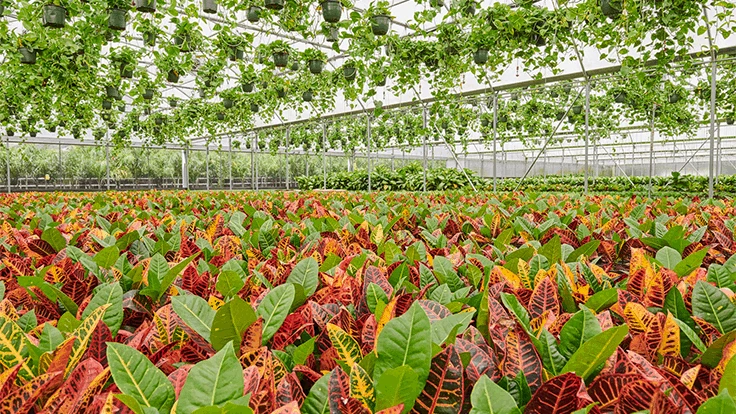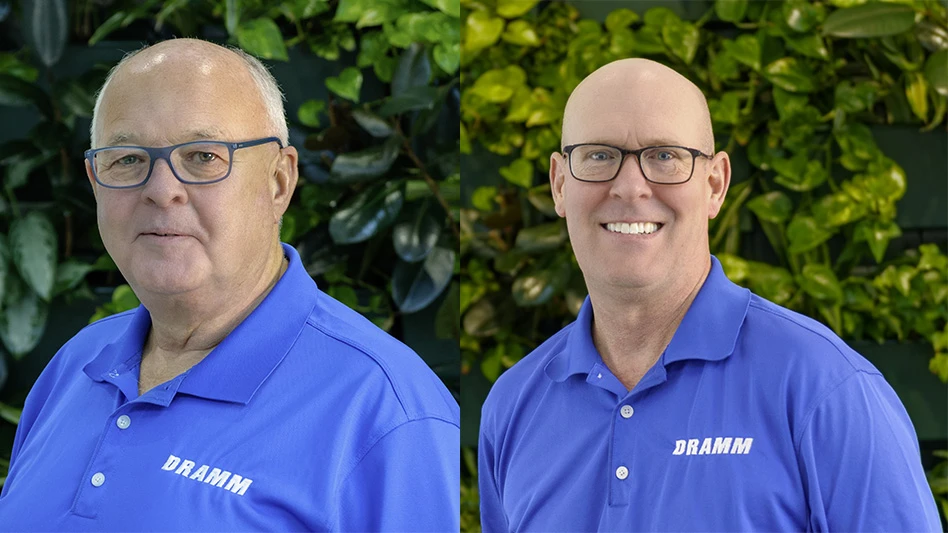
Photo courtesy of Jon Ewing.
The retail landscape is always changing, and with new modes of technology at our fingertips, we can buy and receive products faster than ever before. Garden Center caught up with Jon Ewing, who co-founded the e-commerce platform Lively Root. Located in San Marcos, California, Lively Root’s nursery provides the company with its unique stock of plant varieties that are shipped throughout the U.S. We caught up with Ewing — an industry veteran — to see how business has been since the company’s launch in April, and what challenges and opportunities are on the company’s horizon.
Garden Center: You’ve had a rich background in this industry. Can you walk me through your experience in the field?
Jon Ewing: I started out working in retail nursery and then founded Landtrends, a landscape, construction and maintenance company that I sold to LandCare USA back in the late '90s. I also co-founded Miramar Wholesale Nurseries with my brother during that time period. We actually rolled both of those businesses up and sold them to LandCare, which was a publicly traded company at that time. And from that period, we acquired an ag supply business and sold that to John Deere back in the 2000s.
We've done a lot of consulting. We founded an app called PlantFast and sold that to an online e-commerce business from the East Coast. The idea behind PlantFast was that we would be the 'Shazam of plants meets the Domino's Pizza' of the nursery industry.
GC: Did you say a combination of Shazam and Domino's?
JE: The idea was that you would be able to take a picture of a plant, have it identified and then ultimately have the plant delivered to your home. We set out to embark on developing the app and sold it in development. We ended up reacquiring it a year later and reinvented ourselves as just the e-commerce portion of it.
We were a little more interested greeting this millennial crowd, the younger generation that's in our green space. There's this large demographic out there — maybe the largest discretionary spending demographic in America — and population-wise, the demographic is bigger than the boomers. So, we thought, 'Well, let’s give that a shot, see if we can come up with a site that is inspiring, fun and educational to meet and greet this younger generation on their home turf.' So that's what we've set out to do.
We’ve aligned ourselves with a large wholesale grower in San Diego and we're now one of the few sites that grows and fulfills our own orders. So, the plants that we sell, we also grow and ship from our facility.

A tropical collection of four individual plants. Photo courtesy of Jon Ewing.
GC: How many different types of plants do you sell? How do you determine what to sell?
JE: What we're trying to do is really prove the concept first — that we can grow plants and ship them in a box successfully across the country. And we have determined that the varieties that we've chosen, we can successfully ship. We started with indoor foliage plants because that's what the nursery specializes in. Our plan is to migrate past indoor plants and into the patio and then into landscape plants, or unique and exclusive items. We won't necessarily mimic a garden center. We'd like to be a hybrid garden center that is a little more focused on a younger generation, and what their home and green space may look like.
GC: And that's going to be all online through the e-commerce space?
JE: Yes, it will. We'll either expand some of the product lines that we grow, or we will collaborate with other fulfillments or other growers. We're well-connected to a network of people across the country. I think if we find the need to collaborate with other growers, for the product line that we're interested in, we'll do so. We’re trying to stay data-driven at this point.
We started this with this notion that we have a passion for what we're doing, but we're careful not to posture as we know anything and everything. We're trying to let the data drive us. We just feel like the nursery industry generally has not been frequented by this younger group and we'd like to determine why, and what it is exactly that inspires them.

Lively Root has a wide selection of offerings, and pictured here is the Chinese Evergreen. Photo courtesy of Jon Ewing.
GC: So where is most of your data compiled from? Is it focus group-driven, or do you do a lot of in-house research?
JE: What we're trying to do is explore all social channels that we’re able to tap into. We're trying to access that data to a high degree of detail, based on who our customers are (who we call "guests”) to our site.
When we first started out, we actually had more of a boomer crowd frequenting our products. It was very interesting! And what we determined was that we were being skewed by our own circle of influence. You know — people that we were connected to that were interested in what we were doing and buying from us. As that kind of settled out and we began to market more heavily, we did settle into very much a younger demographic, which is 25- to 34-year-old females.
GC: How do you market to your demographic?
JE: We have many social channels that we go to — Facebook, Instagram, Google Ads. We will be venturing into Pinterest and other social channels too. But we have a keen interest in developing a community, and really becoming a horticultural resource as opposed to simply a marketplace. Our idea is that we don't see ourselves necessarily as a home decor site, but more as a horticultural lifestyle site.

Lively Root features many indoor plant varieties. Photo courtesy of Jon Ewing.
GC: What’s your vision for creating an engaging community?
JE: I think for the most part, that's generated through Facebook and Instagram right now. But we're beginning to outline efforts to reach out more. We’ve received a lot of good reviews. We'd like to interact with people that have frequented our products. In just this short time period, we've had multiple orders from as far away as Alaska.
We've had guests come back four times now to our site, so repeat orders were of high interest to us. You know, ‘What is the lifetime value of a guest?’ And ‘How often they would frequent our site?’ So those are all things we're trying to develop and explore and interpret the data on right now. And it's been very encouraging what we've learned so far, and a lot of good receptivity.
The ability to ship in our proprietary boxing and shipping system has been well-received and something that we continue to develop. We developed four-packs now where we can ship up to four plants in one box. Our idea is that we'd like our guests to feel like it is an experience when they receive something, and we view our products as an option to gifting.
For example, we see our products as a more responsible alternative than a floral option. It’s a living product that maybe has a smaller carbon footprint than what a floral arrangement might have. And part of our approach is to maintain a very eco-friendly approach on our site.
We're trying to create a delivery that when someone receives a package, it’s an experience. It's an attractive boxing system that delivers a plant — one that's healthy and in good condition — without a lot of soil spillage. We want it to be fun.
GC: What roadblocks did you run into when you launched this? Were there any big lessons that you learned, or any 'Oh my God, I didn't anticipate this' moments?
JE: There's a lot of "new-ness" to this process for us. The biggest concern was the site. Site issues were always something we were mindful of. We wanted to develop a site that was of interest to people, more than just a marketplace. Our idea was that we weren't interested in a 'Here's this plant, buy this plant.’ We want it to be more of an experience. We'd like to educate and inspire our guests into making good decisions.
But the shipping was something that we just didn't fully grasp. We did a lot of research on best practices, best ways to ship plants, and spent a lot of time developing our boxes, believe it or not. And I think that was probably the biggest challenge we had in the initial stage — just being able to ship a plant directly to your door in a condition that you'd be happy with and we'd be proud of. And that was a process.

Lively Root's shipping box. Photo courtesy of Jon Ewing.
GC: Did you have to go through research and development with the shipping and box design?
JE: Yes. We did a lot of test shipping before we delivered anything. Since I'm in Northern California, we shipped them back and forth — 460 miles away — and we had orders lost. We wanted to see what would happen if we delivered plants to the desert, and what happens if they sat in the distribution center on a Saturday and weren’t delivered until Monday.
And we just had so many things we've learned. We've found that our boxes almost were surprisingly good in those conditions.
I had one delivered to my house that was accidentally delivered to my neighbor's house. It was our first four-pack that we were testing, and it happened to be on a 100-degree weekend. It was delivered to them on a Friday and I didn't find out it was delivered to their house until I tracked down the GPS driver, so it wasn't until Monday that I got my plants from my neighbor. I opened them up and I couldn't believe what I saw. I mean, they were just perfect inside. It was just like they came out of the hot house. It was fun to see.

Lively Root's nursery. Photo courtesy of Jon Ewing.
GC: Do you have any standards in place for winter?
JE: I'd rather not speak to it in detail because it's proprietary, but it's certainly a great question! We think we've got it! So, we'll see. That's something that was hard for us to test. There are some e-commerce sites that won't ship during inclement weather, but we'd like to think that we're able to do it. And we'll see how that goes, but we've got a high degree of confidence that we've got a system in place that will make it work.
GC: Anything else you’ve learned along the way?
JE: It's a unique environment, there's some very good competitors out there for sure. There are several sites that are very similar to us at this stage. But again, we're not trying to compete with them as a home decor site because we view ourselves as more of a horticultural lifestyle site.
We're excited about this one. It's been a real fun initiative, fun platform. It's absolutely amazing, the reach a platform like this has. It offers a lot of encouragement of the potential and what the possibilities are here.
Latest from Garden Center
- GIE Media Horticulture Group wins five regional 2025 Azbee Awards of Excellence
- Terra Nova Nurseries introduces rust-free and disease-resistant heucherella
- John T. Nickel, founder of Greenleaf Nursery Co., passes away at 89
- Garden Media Group announces sixth annual Women in Horticulture Week
- Star Roses and Plants announces National Knock Out Rose Day
- The Growth Industry Episode 4: How federal budget cuts are affecting horticulture nonprofits
- Pennsylvania Horticultural Society shares top gardening trends from 2025 Philadelphia Flower Show
- California Spring Trials 2026 dates announced





